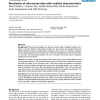BMCBI
2006
13 years 11 months ago
2006
Background: Gene expression microarrays allow the quantification of transcript accumulation for many or all genes in a genome. This technology has been utilized for a range of inv...
BMCBI
2006
13 years 11 months ago
2006
Background: Systematic genome comparisons are an important tool to reveal gene functions, pathogenic features, metabolic pathways and genome evolution in the era of post-genomics....
BMCBI
2006
13 years 11 months ago
2006
Background: Understanding the molecular details of protein-DNA interactions is critical for deciphering the mechanisms of gene regulation. We present a machine learning approach f...
BMCBI
2006
13 years 11 months ago
2006
Background: White Spot Syndrome Virus, a member of the virus family Nimaviridae, is a large dsDNA virus infecting shrimp and other crustacean species. Although limited information...
BMCBI
2006
13 years 11 months ago
2006
Background: With the advent of high-throughput proteomic experiments such as arrays of purified proteins comes the need to analyse sets of proteins as an ensemble, as opposed to t...
BMCBI
2006
13 years 11 months ago
2006
BMCBI
2006
13 years 11 months ago
2006
Background: MannDB was created to meet a need for rapid, comprehensive automated protein sequence analyses to support selection of proteins suitable as targets for driving the dev...
BMCBI
2006
13 years 11 months ago
2006
Background: The splicing of RNA transcripts is thought to be partly promoted and regulated by sequences embedded within exons. Known sequences include binding sites for SR protein...
BMCBI
2006
13 years 11 months ago
2006
Background: Microarray technologies have become common tools in biological research. As a result, a need for effective computational methods for data analysis has emerged. Numerou...
BMCBI
2006
13 years 11 months ago
2006
Background: Molecular evolutionary studies of noncoding sequences rely on multiple alignments. Yet how multiple alignment accuracy varies across sequence types, tree topologies, d...



